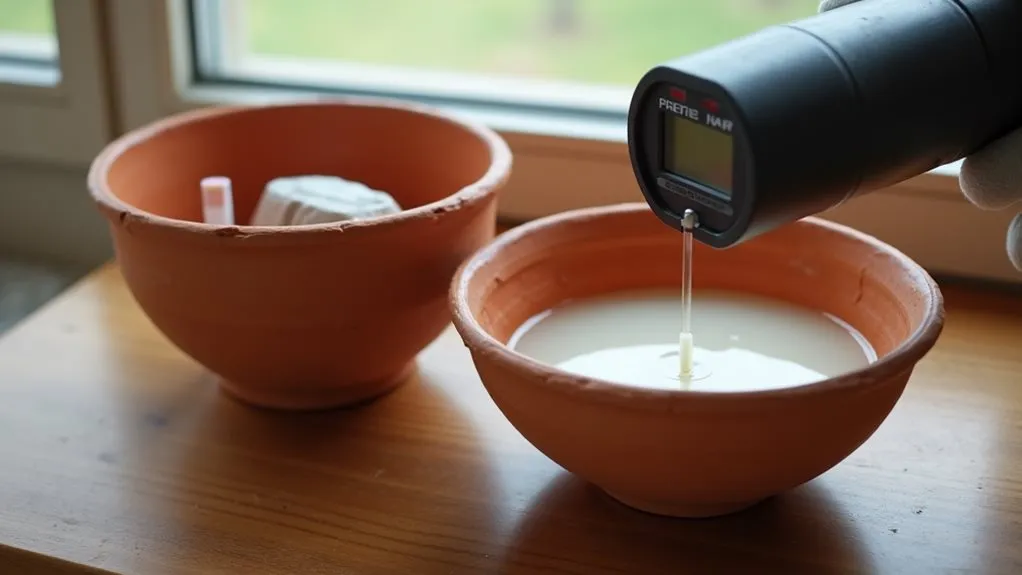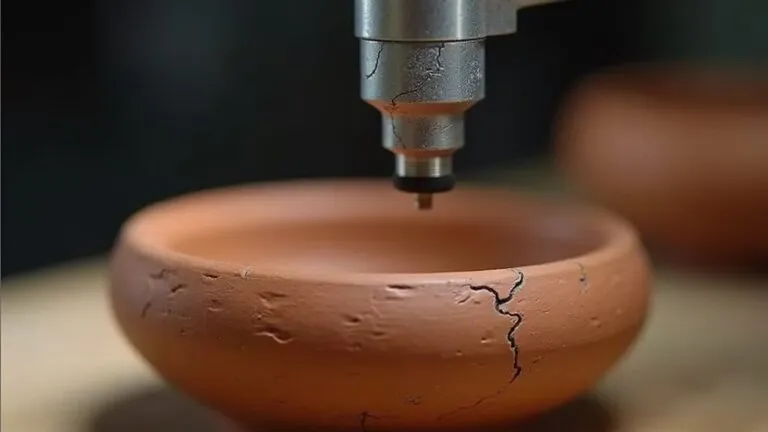You can determine if handmade pottery is lead-free through several quick checks. Look out for bright orange, red, or yellow glazes, which often signal lead presence. Avoid pieces with white logos, raised decals, or irregular hand-painted designs, as these features commonly contain lead. Use a home testing kit like LeadCheck swabs for a quick assessment, or send samples to a professional lab for thorough analysis. Pay attention to the pottery's origin – items from reputable manufacturers with transparent testing practices are safer than flea market finds or antiques. Stick to natural, certified lead-free clay bodies and well-documented glazes. The world of safe pottery selection has many more fascinating aspects to explore.
Understanding Lead Risks in Pottery

How can you tell if that beautiful handmade pottery poses a lead risk? You'll want to pay special attention to certain warning signs that could indicate potential lead exposure from your ceramic pieces.
Those charming handmade pieces with irregular shapes or crude appearances might be hiding a not-so-charming secret, while brightly colored pottery, especially in orange, red, or yellow, often contains lead to enhance those eye-catching hues. Acidic foods and drinks can increase lead leaching from these ceramic pieces.
If you're a fan of antique ceramics or love hunting for unique pieces at flea markets, you'll need to be extra cautious about pottery health risks.
Damaged or worn ceramics can leach lead more easily, and no amount of washing will make them safer.
The good news? You don't have to give up your pottery passion – just use lead-testing kits to check pieces before using them with food.
Visual Signs of Lead Content
A trained eye can spot several telltale signs of lead in handmade pottery. When you're examining color indicators, pay special attention to bright orange, red, or yellow pieces – these vibrant hues often signal lead content. A piece's unique surface texture can help authenticate the pottery while assessing potential lead content.
You'll also want to look closely at white logos or raised decals, as they're frequent lead culprits.
When it comes to glaze characteristics, watch out for rough, uneven surfaces or hand-painted designs that might hint at lead-based materials.
Those charming pieces from flea markets or street vendors? They're more likely to contain lead than commercially produced items.
If you notice low-fire glazes (they're typically softer and less durable) or pottery without clear manufacturing information, it's best to be cautious.
Safe Clay Source Identification

When selecting clay for handmade pottery, identifying safe sources becomes your first line of defense against potential hazards.
You'll want to focus on clay sourcing from reputable manufacturers who prioritize safety and contamination prevention. Wearing rubber protective gloves while handling clay materials helps prevent absorption of harmful compounds through the skin.
Today's innovative potters are turning to premixed, wet clay bodies that minimize dust exposure and health risks.
Here's what you should look for in your clay source:
- Commercial clays labeled as "low free silica"
- Natural, lead-free clay bodies from established manufacturers
- Properly processed stoneware or porcelain clays
- Wet-mixed options that reduce dust exposure
Don't be tempted by those bargain-priced mystery clays at the craft store – your health is worth the investment in quality materials.
Testing Methods and Equipment
If you're wondering whether your handmade pottery is safe, you've got two main ways to check for lead: home testing kits and professional lab analysis.
Simple home testing kits, like LeadCheck swabs, can give you quick results by changing color when they detect lead on your pottery's surface.
For the most accurate results, you'll want to contemplate sending your pieces to a certified laboratory, where they'll use sophisticated equipment to measure exact lead levels and give you detailed safety reports. Sydney Analytical Labs conducts professional testing for ceramics in Australia.
Home Testing Kit Basics
Three main types of lead test kits can help you determine if your handmade pottery contains harmful substances. The EPA-recognized options include LeadCheck™, D-Lead®, and State of Massachusetts kits, though you'll want to verify you're choosing one specifically designed for ceramics.
When selecting your home kit options, consider both testing accuracy and ease of use. Most quality test kits provide results in 30 seconds.
Before you begin testing, keep these essential factors in mind:
- Don't assume modern ceramics are automatically lead-free
- Follow the kit's instructions precisely for reliable results
- Keep testing materials away from children and pets
- Never use your mouth to moisten test swabs
You'll need to prepare your pottery properly before testing, usually by cleaning the surface thoroughly.
Professional Lab Analysis
Although home testing kits offer quick results, professional lab analysis provides the most accurate and thorough assessment of lead content in handmade pottery.
You'll find that certified labs use sophisticated testing protocols, including acid leach testing and frit analysis, to detect even trace amounts of lead.
When you choose a lab with proper laboratory accreditation, they'll use advanced equipment like spectrophotometers and specialized reagent solutions to analyze your pottery.
They'll typically soak your pieces in dilute acid for 24 hours, then run extensive tests that'll tell you exactly what's in your ceramics.
The FDA has established maximum allowable levels for lead and cadmium contamination in ceramic ware.
While it might seem like overkill to send your favorite mug to a lab, you'll get detailed reports that leave no question about safety.
It's like getting a PhD-level examination of your pottery instead of a quick health check!
Choosing Lead Free Manufacturers

When selecting manufacturers of lead-free pottery, you'll need to focus on those with transparent testing practices and strict quality control standards.
Traditional manufacturing methods can introduce lead contamination during the glazing and firing process. Look for manufacturer certifications that demonstrate their commitment to safety and quality. You'll want to partner with companies that regularly test their raw materials and maintain detailed records of their production processes.
Here's what to look for in a reliable pottery manufacturer:
- Thorough testing of all raw materials before production
- Published test results that you can easily access
- Clear documentation of their lead-free manufacturing processes
- Regular third-party testing and quality control inspections
Pottery Safety Best Practices
Beyond selecting reliable manufacturers, implementing proper safety practices in pottery-making protects both artisans and end users.
You'll want to establish smart cleaning techniques, like wiping surfaces with wet sponges and using HEPA vacuums to control dust. Using wet cloths for wiping helps trap potentially harmful particles before they become airborne. When it comes to tool storage, keep your equipment organized in designated spots to prevent accidents and contamination.
Don't forget about personal protection – you're not being overly cautious by wearing safety glasses and using proper ventilation.
Think of your studio as your sanctuary where safety comes first! Keep your materials properly labeled and stored, and always clean up spills right away.
Final Thoughts
Like a watchful parent, you'll want to protect yourself and your family from lead exposure in handmade pottery. By following proper testing methods, sourcing your clay carefully, and working with reputable manufacturers, you can enjoy beautiful handcrafted pieces with peace of mind. Remember, when it comes to lead safety, it's better to be thorough than sorry – your health depends on making informed choices about the pottery you bring into your home.




